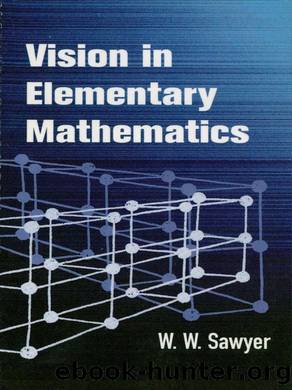Vision in Elementary Mathematics (9780486143620) by Sawyer W. W

Author:Sawyer, W. W. [Sawyer, W. W.]
Language: eng
Format: epub
ISBN: 9780486143620
Publisher: Inscribe Digital
Published: 2012-10-10T05:00:00+00:00
ADDITION
We have already noticed that arithmetic tends to give children the impression that an âanswerâ should not involve any plus signs. This leads to a common type of mistake. If you ask children to add 2a and 3b, they are not happy with the correct answer 2a+3b. This answer admittedly is an anticlimax! Pupils tend to make such guesses as 5a or 5b or, on occasion, 5c. However, if our friends, Alf, Betty, and Charles are invited each to think of a number, there just is no way of saying more simply âTwice Alfâs number added to 3 times Bettyâs numberâ. It will not (as a rule) be 5 times Alfâs number (as the answer 5a alleges), nor 5 times Bettyâs (as 5b would imply) and there is certainly no reason to suppose it will be 5 times Charlesâ number, unless telepathy has been taking place. One can illustrate the meaning of 2a+3b as we did in Chapter 3, with boys standing on menâs heads. The man can be supposed to be a feet high, and the boy b feet high. It is then clear that the picture for 3a+2b (the height in feet of 3 men and 2 boys) is not the same as that for 5a (the height in feet of 5 men), nor is it the same as 5b (the height in feet of 5 boys).
The difficulty here is that a question such as âAdd a to bâ is rather like the riddle, âWhat is the difference between an elephant and a postbox?â People rack their brains for some witty epigram contrasting the two things. Whereas in fact no such epigram is known. The riddle merely gives you a chance to insult the person when he admits that he does not know the difference between an elephant and a postbox. In the same way, when we ask children to add a and b, they start looking for some profound mathematical idea about the sum of two numbers. No such idea exists. The question is at first purely one of notation. It might prove less misleading if we asked, âIf a stands for a number Alf is thinking, of, and b for a number Betty is thinking of, how should we write in shorthand Alfâs number added to Bettyâs?â The pupils would then probably answer a+b. We might then ask, âIs there any shorter way of writing it than a+b?â and some discussion might be necessary before the pupils reached the conclusion, âNoâ.
We begin to reach something that looks more like a serious calculation, when we ask for the sum of 3x and 4x. We have already had several ways of picturing this. We can consider x feet to be the height of a man (Chapter 3), or x to be the number of stones in a bag (Chapter 4), or the number of objects in a line, with a long thin cloud preventing us from seeing their number (Chapter 5). By any of these devices we can satisfy ourselves that 3x+4x=7x.
Download
This site does not store any files on its server. We only index and link to content provided by other sites. Please contact the content providers to delete copyright contents if any and email us, we'll remove relevant links or contents immediately.
| Applied | Geometry & Topology |
| History | Infinity |
| Mathematical Analysis | Matrices |
| Number Systems | Popular & Elementary |
| Pure Mathematics | Reference |
| Research | Study & Teaching |
| Transformations | Trigonometry |
Modelling of Convective Heat and Mass Transfer in Rotating Flows by Igor V. Shevchuk(6391)
Weapons of Math Destruction by Cathy O'Neil(6142)
Factfulness: Ten Reasons We're Wrong About the World – and Why Things Are Better Than You Think by Hans Rosling(4694)
Descartes' Error by Antonio Damasio(3229)
A Mind For Numbers: How to Excel at Math and Science (Even If You Flunked Algebra) by Barbara Oakley(3217)
Factfulness_Ten Reasons We're Wrong About the World_and Why Things Are Better Than You Think by Hans Rosling(3197)
TCP IP by Todd Lammle(3133)
Fooled by Randomness: The Hidden Role of Chance in Life and in the Markets by Nassim Nicholas Taleb(3044)
Applied Predictive Modeling by Max Kuhn & Kjell Johnson(3018)
The Tyranny of Metrics by Jerry Z. Muller(3000)
The Book of Numbers by Peter Bentley(2908)
The Great Unknown by Marcus du Sautoy(2646)
Once Upon an Algorithm by Martin Erwig(2598)
Easy Algebra Step-by-Step by Sandra Luna McCune(2579)
Lady Luck by Kristen Ashley(2532)
Practical Guide To Principal Component Methods in R (Multivariate Analysis Book 2) by Alboukadel Kassambara(2497)
Police Exams Prep 2018-2019 by Kaplan Test Prep(2483)
All Things Reconsidered by Bill Thompson III(2355)
Linear Time-Invariant Systems, Behaviors and Modules by Ulrich Oberst & Martin Scheicher & Ingrid Scheicher(2333)
